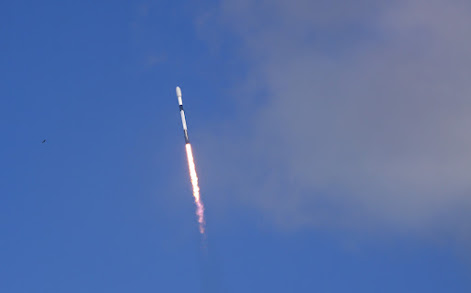For the second time in three weeks, SpaceX has launched a Falcon 9 rocket booster.
With another Starlink flight from Cape Canaveral on Friday, SpaceX continues to ramp up its launch rate, completing a quick recycle with a Falcon 9 first stage booster flying for the second rocket in 21 days.
The Starlink 4-16 mission was the 151st Falcon 9 launch since SpaceX introduced their workhorse vehicle on June 4, 2010, and the 43rd Falcon 9 flight largely devoted to delivering Starlink broadband relay stations into orbit. This was SpaceX's 17th mission of the year, and the company's sixth Falcon 9 launch in April, making it the company's most in a single month.
This year, SpaceX has increased the frequency of its launches. Elon Musk, SpaceX's founder and CEO, has said that the business plans to conduct 60 Falcon 9 and Falcon Heavy missions in 2022, substantially doubling the 31 missions completed last year. SpaceX maintains its launch rate by reusing rocket boosters and payload fairing shells. So far this year, just one of the 17 Falcon 9 missions has utilised a brand-new rocket.
After launching with Axiom's Ax-1 mission on April 8, the rocket that flew on Friday's flight — tail number B1062 — landed on SpaceX's drone ship "A Shortfall of Gravitas" in the Atlantic Ocean. SpaceX connected the booster stage with a new second stage and wheeled the rocket into the hangar at pad 40 after the drone ship brought it to port for inspections and minor maintenance.
SpaceX personnel connected the Falcon 9 with its cargo of 53 Starlink satellites, which were already enclosed within the rocket's nose shroud, inside the hangar. Thursday, SpaceX wheeled the Falcon 9 to the launch pad just north of the hangar, then lifted it upright for final launch preparations.
The launch on Friday set a new record for the shortest time between flights of the same Falcon launcher, beating the previous mark of 27 days.
At 5:27:10 p.m. EDT (2127:10 GMT) Friday, the Falcon 9 started its Merlin main engines and lifted away from pad 40 at Cape Canaveral Space Force Station after a successful countdown. The Merlin 1D engines, which used kerosene and liquid oxygen as propellants, propelled the 229-foot-tall (70-meter) rocket through the stratosphere on a path northeast from Florida's coast.
The first stage of the Falcon 9 shut down and ejected amid the fading rumbling of the rocket engines, then arced to a height of approximately 400,000 feet before landing propulsively vertically on the drone ship. "About eight-and-a-half minutes after launch, read the instructions."
The Falcon 9's upper stage delivered the 53 Starlink satellites into a near-circular orbit at an average height of 192 miles (310 kilometres) for deployment of the 53 flat-packed spacecraft, each weighing a little more than a quarter tonne, as it did on most previous Starlink flights.
The second stage fired its single vacuum-optimized engine twice to put the Starlink satellites in the proper separation orbit. The Starlink satellites were launched around 59 minutes into the mission, south of Australia.
The satellites were launched into an orbit with a 53.2 degree inclination to the equator, one of five orbital "shells" utilised in SpaceX's worldwide internet network.
The Starlink satellites will utilise on-board ion engines and extend solar arrays to reach their operational orbit at an altitude of 335 miles (540 kilometres), where they will begin beaming broadband signals to users.
To date, SpaceX has launched 2,441 Starlink satellites, including spacecraft that have been decommissioned or have failed. According to a list kept by Jonathan McDowell, an astrophysicist who analyses spaceflight activities, more than 2,100 of those satellites are in orbit and operational as of Friday.
This makes the Starlink fleet the world's biggest satellite constellation, outnumbering competitor OneWeb's internet satellite fleet by roughly five times.



Comments
Post a Comment